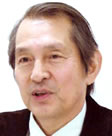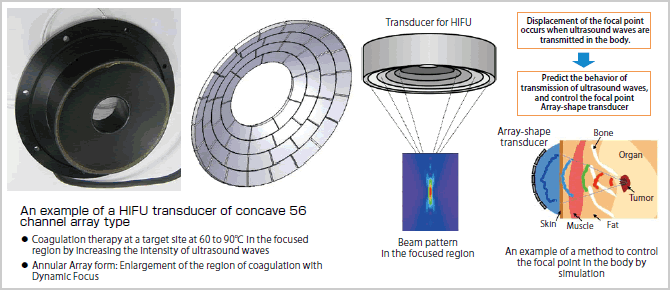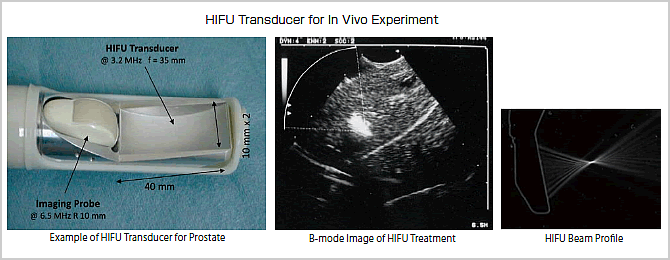
Future of Life Science Pioneered by Biosupercomputing
Sonic simulation research in the body which is essential for promotion of
ultrasound therapy and development of therapeutic apparatus

Extraordinary researcher, Department of Mechanical Engineering,
School of Engineering, University of Tokyo
Akira Sasaki
■In order to promote the HIFU treatment being led by Japan
━ Dr. Sasaki, you have been in the industrial world up until very recently.
●Sasaki(dispensed with Mr.) I was engaged in the design and development of an ultrasound diagnostic system in the company called as Hitachi Medical Corporation for a long time. A digital ultrasound diagnostic system which appeared in the latter half of the 1980s has evolved at a rapid pace since the mid-1990s, it became possible to provide more information for clinical diagnosis, and when its performance improved, its scope became very large. About 5 years ago, moreover, ultrasound waves came to be utilized not only for diagnosis but also for treatment as a global movement, and because we have to do it in Japan, I was engaged in the development of an ultrasound therapy system. I retired from the company at the mandatory age in March 2010, joined the university in June, and have been addressing the development of HIFU (High Intensity Focused Ultrasound) using ultrasound waves. I think that my work is to play the role of interface between “industry” and “the academic sector” by utilizing my previous experience in the company.
━ What is the HIFU therapeutic system?
●Sasaki HIFU is a system focusing ultrasound waves on one point in the body and performing treatment by making only the focused part high temperature, which is also called a “high Intensity therapeutic ultrasound” For example, the present cancer treatment consists of drugs and surgery, both of which are associated with severe suffering and stress. However, HIFU does not need to cut the body and causes no suffering as with anticancer drugs. If a patient undergoes treatment in the morning, he/she can return to home in the afternoon. Moreover, radiation therapy can be done only once, but HIFU treatment has the advantage that it can be repeated many times. The research ongoing now is a DDS (Drug Delivery System)- type treatment using ultrasound waves. This is a treatment focusing a micelle containing a drug on a site such as cancer through a blood vessel, and breaking the particle with faint ultrasound waves to perform topical treatment. As described, the HIFU therapeutic system has greater potential. However, at present, Japanese companies are doing the research, but not commercialization or manufacture.
━ Why are Japanese manufacturers inactive?
●Sasaki The problem of ensuring safety is a major bottleneck. Considering the liability issue in failure of treatment, manufacturers cannot start development so easily. In the case of a drug, it is OK if suitable effects can be obtained considering the risk and benefit ratio but in the case of a treatment, failure is not permitted, and issues of liability and compensation may occur. Another issue concerns the market. An ultrasound diagnostic system is introduced to a lot of medical institutions and has good marketability, but the market for treatment is limited, and the cost will be high. Moreover, a therapeutic apparatus has to undergo clinical evaluation. Considering the cost, period and manpower involved in a clinical trial, it may be particularly unprofitable for the manufacturer. Considering the global movement, however, an Israeli company has already developed this system in about 2002, which was approved by the FDA in 2004 and launched. In the U.S.A., the GE company is dealing with it. Philips will launch it in 2011. Siemens is developing a prototype and will start clinical trials in 2011. In order to establish the field of HIFU therapy, moreover, the Focused Ultrasound Surgery Foundation was already established in Western countries in 2006, and research and development have begun. If Japan does not start development despite the fact that 3 of the world’s leading companies are moving ahead with manufacture by shifting from diagnosis to treatment, 100 % of the market will be occupied by overseas companies. Because we have to promote HIFU therapy from Japan in some way, it was decided to establish a consortium in Japan. In order that the Japanese HIFU therapeutic system survives in the future, it is important to build a strategy for Japan to win the world. This is not a time when one domestic manufacturer can win. To improve our chances of success, we will work together in an all-Japan organization.
■Making a bridge between“ industry” and the “academic sector” is my job.
━ What is the first issue in developing the HIFU therapeutic system from Japan?
●Sasaki More than anything else, we have to emphasize the safety of treatment. HIFU therapy is a method to directly treat only a target site in the body. In order to perform treatment safely, precise imaging diagnosis, navigation and biological simulation are important keys. First, in order to draw up a solid therapeutic plan, a precise preoperational imaging diagnosis should be made by making effective use of CT, MRI, US (ultrasound diagnostic system) and RI (nuclear medicine diagnosis system). It is required to observe in real time during operation, and to conduct appropriate guided navigation. Unlike surgery which directly opens the body, moreover, this HIFU therapy only looks at images. The efficacy of treatment is also evaluated with images. In order to observe the progress of treatment, a biological simulation is therefore essentially required.
━ Does a safety issue still remain in the HIFU therapy itself?
●Sasaki Ultrasound waves are characterized in that refraction and reflection occur due to acoustic impedance (density× sound velocity). Like light, ultrasound waves bend when they enter a different medium. Therefore, refraction and a change in sound velocity with the fats, muscles and organs in the body affect the beam characteristics of ultrasound waves and displacement of the focal point. In the bone, moreover, thermal changes occur due to absorption of ultrasound waves, and heat diffusion may also occur at a blood flow-rich site. Moreover, ultrasound waves are influenced in the body by various factors such as movement of organs such as the heart and presence of air bubbles such as intestinal gas which induce phase disturbance or sound disturbance. It is never easy. In order to avoid these influences in the therapeutic plan, it is essential to measure the hurdles exactly, and to perform optimum control. For this, it is necessary to simulate the sound characteristics in the body in advance.
━ Does the result of such a biological simulation assist the design of HIFU therapy?
●Sasaki One way is optimization design of the ultrasound beam including the transducer generating ultrasound waves. In order to irradiate so that the ultrasound waves are precisely focused on the target site, the processes of penetration through the skin on the body surface, muscles, fats and organs will be important. Moreover, procedures for avoiding intestinal gas and bones which may become large hurdles are also required. In a transducer consisting of multiple elements, each element is limited so as to avoid irradiation to the place where bones and air bubbles are present in advance, and refractive correction is performed by giving the delay time. By these procedures, a method of irradiating ultrasound waves precisely to the target site has been studied. Moreover, a method to shorten the treatment time has also been studied by predicting the increase in temperature at the coagulation site, and by irradiating while continuously changing the irradiation position. In conventional HIFU therapy, some time to cool off heat after irradiation was required, and it took 2 to 4 hours for treatment, but this is an attempt to shorten the treatment time largely by continuous coagulation while moving. In optimization design of HIFU coagulation, optimization of multi-cauterizing design to shorten the treatment time, and minimization of side effects, simulation will play an important role.

━ In order to establish a HIFU therapy system af ter overcoming various issues, is biological simulation still important?
●Sasaki If navigation and simulation are done correctly, the safety of HIFU therapy will increase. I want to make treatment safe by conducting experiments based on this. In Europe, research has already progressed to an attempt of treating brain tumors through the cranial bone. By calculating the refractive index of cranial bone, they are attempting to focus ultrasound waves on a point in the brain. It is wonderful that treatment can be performed without opening the brain. The idea is wonderful. I think it is very difficult to realize it, but simulation will become truly important in such research.
━ In promoting the technical development of such HIFU therapy, do you think that computational resources such as a ten quadrillion speed computer will make a significant contribution?
●Sasaki It is absolutely necessary, and I expect it. In the Organ and Body Scale Team, development of a focused ultrasound simulator is actually ongoing, and I would be a fool not to take advantage of this (laughing). As described previously, since this treatment can be observed only on images, a simulation is required for monitoring processes. I think that the research itself cannot be done without simulation.
━ If the safety of HIFU therapy increases along with the progress of simulation research, will the Japanese manufacturer go on to develop or manufacture a HIFU therapy system?
●Sasaki Yes, it will. Considering the global trend, the time for development and manufacture has come. For this, if the “academic sector” researches what degree of safety has been established, “industry” will take action, and I think that my mission is to make this possible.

BioSupercomputing Newsletter Vol.3
- SPECIAL INTERVIEW
- The role of supercomputers is important for integrating various leading-edge research bases for proactive use.
Manager Clinical Development Planning and Management
Mochida Pharmaceutical Co., Ltd. Visiting Professor Tohoku University Kazumi Nishijima - Sonic simulation research in the body which is essential for promotion of ultrasound therapy and development
of therapeutic apparatus
Extraordinary researcher, Department of Mechanical Engineering, School of Engineering, University of Tokyo Akira Sasaki
- Report on Research
- Achievement of a Multiscale Molecule Simulation of QM/MD/CGM(Molecular Scale WG)
Institute for Protein Research, Osaka University
Yasushige Yonezawa / Shusuke Yamanaka / Hiromitsu Shimoyama / Hideki Yamazaki / Haruki Nakamura
RIKEN, Computational Science Research Program Ikuo Fukuda - Towards development and experimental demonstration of liver model based
on large-scale metabolic simulation at individual cellular level (Cell Scale WG)
School of Medicine, Keio University Ayako Yachie-Kinoshita - Exhaustive Protein-Protein Interaction Network Prediction by Using MEGADOCK (Data Analysis Fusion WG)
Graduate School of Information Science and Engineering, Tokyo Institute of Technology
Yutaka Akiyama / Yuri Matsuzaki / Nobuyuki Uchikoga / Masahito Ohue - Whole Brain Simulation of the Insect Olfactory System
Research Center for Advanced Science and Technology, The University of Tokyo Tomoki Kazawa, Stephan Shuichi Haupt
- Report
- The summer school 2010 for the Integrated Simulation of Living Matter was held.
RIKEN, Computational Science Research Program Yasuhiro Ishimine (Organ and Body Scale WG)
The Institute of Medical Science, The University of Tokyo Teppei Shimamura (Data Analysis WG)
RIKEN, Computational Science Research Program Yasuhiro Sunaga (Cell Scale WG)
Kyoto University Graduate School of Informatics Naoki Honda (Brain and Neural WG)
RIKEN, Computational Science Research Program Gen Masumoto (High-Performance Computing Team)
RIKEN, Computational Science Research Program Kosuke Matsunaga (Molecular Scale WG) - After participation in the summer school 2010 for the Integrated Simulation of Living Matter
First year of doctor's course, The University of Tokyo Graduate School of Science Ken Saito
